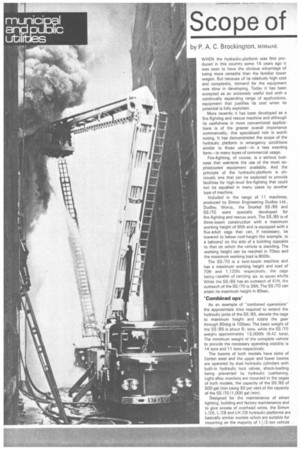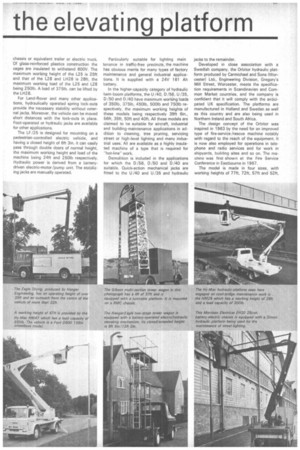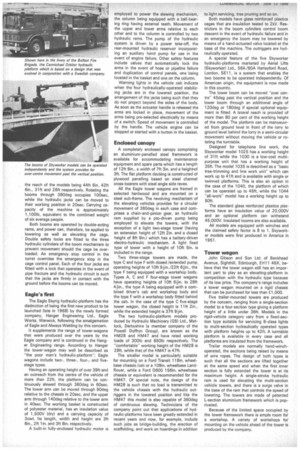Scope of the elevating platform
Page 86

Page 87

Page 88

If you've noticed an error in this article please click here to report it so we can fix it.
WHEN the hydraulic platform was first produced in this country some 15 years ago it was seen to have the obvious advantage of being more versatile than the familiar tower wagon. But because of its relatively high cost and complexity, demand for the equipment was slow in developing. Today it has been accepted as an extremely useful tool with a continually expanding range of applications, equipment that justifies its cost when its potential is fully exploited.
More recently it has been developed as a fire-fighting and rescue machine and although its usefulness in more conventional applications is of the greater overall importance commercially, this specialized role is worth noting. It has demonstrated the scope of the hydraulic platform in emergency conditions similar to those used—in a less exacting form—in many types of commercial usage.
Fire-fighting, of course, is a serious business that warrants the use of the most sophisticated equipment available. And the principle of the hydraulic-platform is obviously one that can be exploited to provide facilities for high-level fire-fighting that could not be equalled in many cases by another type of machine.
Included in the range of 11 machines, produced by Simon Engineering Dudley Ltd., Dudley, Worcs., the Snorkel S5/85 and SS /70 were specially developed for fire-fighting and rescue. work. The SS /85 is of three-boom construction with a maximum working height of 85ft and is equipped with a five-adult cage that can, if necessary, be lowered to below roof-height (for example, to a balcony) on the side of a building opposite to that on which the vehicle is standing. The working height can be reached in 70sec and the maximum working load is 8001b.
The SS /70 is a twin-boom machine and has a maximum working height and load of 70ft and 1,12015 respectively, the cage being capable of carrying six to seven adults. While the SS /85 has an outreach of 41ft, the outreach of the SS /70 is 35ft. The SS /70 can attain its maximum height in 60sec.
'Combined ups'
As an example of "combined operations" the approximate time required to extend the hydraulic jacks of the SS /85, elevate the cage to maximum height and rotate the gear through 90deg is 100sec. The basic weight of the SS /85 is about 8 tons, while the SS /70 weighs approximately 15,000lb (6.42 tons). The minimum weight of the complete vehicle to provide the necessary operating stability is 14 tons and 11 tons respectively.
The booms of both models have skins of Corten steel and the upper and lower booms are operated by dual hydraulic cylinders with built-in hydraulic lock valves, shock-loading being prevented by hydraulic cushioning. Light-alloy monitors are mounted in the cages of both models, the capacity of the SS /85 of 500 gal /min being 50 per cent of the capacity of the SS /70 (1,000 gal /min).
Designed for the maintenance of street lighting, building and factory maintenance and to give access of overhead wires, the Simon L/25, L/28 and LH /28 hydraulic platforms are basically similar models which are suitable for mounting on the majority of 11/2-ton vehicle chassis or equivalent trailer or electric truck. Of glass-reinforced plastics construction the cages are insulated to withstand 600V. The maximum working height of the L25 is 25ft and that of the L28 and LH28 is 2811, the maximum working load of the L25 and L28 being 250Ih. A load of 375113. can be lifted by the LH28.
For Land-Rover and many other applications, hydraulically operated spring lock-outs provide the necessary stability without external jacks. Moreover, the vehicle can be moved short distances with the lock-outs in place. Foot-operated or hydraulic jacks are available for other applications.
The LF /25 is designed for mounting on a pedestrian-controlled electric vehicle, and having a closed height of 6ft 3in. it can easily pass through double doors of normal height, the maximum working height and load of the machine being 24ft and 250Ib respectively. Hydraulic power is derived from a batterydriven electric-motor /pump unit. The stabilizing jacks are manually operated. Particularly suitable for lighting main tenance in traffic-free precincts, the machine has obvious merits for many types of factory maintenance and general industrial applications. It is supplied with a 24V 161 Ah battery.
In the higher-capacity category of hydraulic twin -boom platforms, the U /40, D /56, U /35, D /50 and D /40 have maximum working loads of 350Ib, 3751b, 450Ib, 5001b and 750Ib respectively, the maximum working heights of these models being respectively 39ft 6in., 56ft, 35ft, 50ft and 40ft. All these models are claimed to he suitable for aircraft, industrial and building-maintenance applications in addition to cleaning, tree pruning, servicing street or high-level lighting and many industrial uses. All are available as a highly insulated machine of a type that is required for "hot-line" work.
Demolition is included in the applications for which the D156. D /50 and D /40 are suitable. Quick-action mechanical jacks are fitted to the U /40 and U /35 and hydraulic jacks to the remainder.
Developed in close association with a Swedish company, the Orbiter hydraulic platform produced by Carmichael and Sons (Worcester) Ltd:, Engineering Division, Gregory's Mill Street, Worcester, meets the specification requirements in Scandinavian and Common Market countries, and the company is confident that it will comply with the anticipated UK specification. The platforms are manufactured in Holland and Sweden as well as this country and are also being used in Northern Ireland and South Africa.
The design concept of the Orbitor was inspired in 1963 by the need for an improved type of fire-service /rescue machine notably with regard to the reach of the equipment. It is now also employed for operations in telephone and radio services and for work in shipyards, building sites and so on. The machine was first shown at the Fire Service Conference in Eastbourne in 1967.
The model is made in four sizes, with working heights of 771t, 72ft, 57ft and 52ft, the reach of the models being 44ft 61n, 42ft 6in., 31ft and 26ft respectively. Rotating the booms through 360deg occupies 100sec, while the hydraulic jacks can be moved to their working position in 20sec. Carrying capacity of the machine is approximately 1,1001b, equivalent to the combined weight of six average people.
Both booms are operated by double-acting rains, and power can, therefore, be applied to lowering as well as elevating the cage. Double safety locks are fitted to the three hydraulic cylinders of the boom mechanism to prevent movement should the cage be overloaded. An emergency . stop control in the turret overrides the emergency stop in the cage control panel. Each of the four jacks are fitted with a lock that operates in the event of pipe fracture and the hydraulic circuit is such that the jacks are firmly in contact with the ground before the booms can be moved.
Eagle's first
The Eagle Skyrig hydraulic-platform has the distinction of being the first new product to be launched hate in 1968) by the newly formed company, Hanger Engineering Ltd., Eagle Works, Warwick, following the amalgamation of Eagle and Always Welding by this concern.
It supplements the range of tower-wagons that were produced over the years by the Eagle company and is continued in the Hanger Engineering range. According to Hanger the tower-wagon may well be described as "the poor man's hydraulic-platform"; Eagle wagons include two-, three-, four-, and fivestage types.
Having an operating height of over 39ft and an outreach from the centre of the vehicle of more than 22ft, the platform can be continuously slewed through 360deg in 60sec. The lower arm can be moved through 90deg relative to the chassis in 20sec, and the upper arm through 140deg relative to the lower arm in 40sec. The working basket is constructed of polyester material, has an insulation value of 1,500V (dry) and a carrying capacity of 3cwt. Its length, width and height are 3ft 8in., 2ft lin. and 3ft Bin, respectively.
A built-in fully-enclosed hydraulic motor is employed to power the slewing mechanism, the column being equipped with a ball-bearing ring having external teeth. Movement of the upper and lower arms relative to each other and to the column is controlled by two hydraulic rams. The pump of the hydraulic system is driven by a power take-off, the rear-mounted hydraulic reservoir incorporating an auxiliary hand pump for use in the event of engine failure. Other safety features include valves that automatically lock the arms in the event of hose or pipeline failure and duplication of control panels, one being located in the basket and one on the column.
Warning lights in the vehicle cab indicate when the four hydraulically-operated stabilizing jacks are in the lowered position, the arrangement of the jacks being such that they do not project beyond the sides of the body. As soon as the actuator handle is released the arms are locked in place, movement of the arms being pre-selected electrically by means of a switch. Speed of movement is controlled by the handle. The vehicle engine can be stopped or started with a button in the basket.
Enclosed canopy
A completely enclosed canopy comprising an aluminium-panelled steel framework is available for accommodating maintenance equipment and spare parts which has a length of 12ft 9in., a width of 7ft 3in. and a height-of 3ft. The flat platform decking is constructed of plywood panelling based on steel channel cross-bearers with steel angle side raves.
All the Eagle tower wagons are framed in selected hardwood and are mounted on a steel sub-frame. The revolving mechanism of the elevating vehicles provides for a circular movement of 360deg in each case and comprises a chain-and-pinion gear, an hydraulic ram supplied by a pto-driven pump being employed to elevate the towers, with the exception of a light two-stage tower (having an extension height of 12ft 2in. and a closed height of 8ft 9in.) which has a battery-driven electro-hydraulic mechanism, A light fixed type of tower with a height of 10ft Sin. is included in the range.
Two three-stage towers are made, the type C and type F with closed /extended pump, operating heights of 10ft 91in./22ft 6-0n., the type F being equipped with a workshop body. Types A, C and F four-stage tower wagons have operating heights of 10ft 6Fn. to 28ft the type A being equipped with a combined driver's cab and workshop body and the type F with a workshop body fitted behind the cab. In the case of the type C five-stage tower wagon, the closed height is 11ft 2in., while the extended height is 37ft 9.0n.
The two hydraulic-platform models produced by Hydraulic Machinery (GB) Ltd., Matlock, Derbyshire (a member company of the Powell Duffryn Group), are known as the HM28 and HM47 and have rated working loads of 3001b and 650Ib respectively. The "comfortable" working height of the HM28 is 28ft, while that of the HM47 is 47ft.
The smaller model is particularly suitable for mounting on a Ford Transit 118in. wheelbase chassis /cab or a 109in. wheelbase LandRover, while a Ford D600 156in. wheelbase chassis or equivalent is recommended for the HM47. Of special note, the design of the HM28 is such that no load is transmitted to the vehicle chassis with the hydraulic outriggers in the lowered position and like the HM47 this model is also capable of 360deg of continuous slewing. Technicians of the company point out that applications of hydraulic-platforms have been greatly extended in recent years and now, for example, include such jobs as bridge-building, the erection of scaffolding, and work on hoardings in addition to light servicing, tree pruning and so on.
Both models have glass reinforced plastics cages that are insulation tested to 2kV. Restrictors in the boom cylinders control boom descent in the event of hydraulic failure and in an emergency the boom may be lowered by means of a hand-actuated valve located at the base of the machine. The outriggers are hydraulically operated.
A special feature of the five Skyworker hydraulic-platforms marketed by Aerial Lifts (Skyworker) Ltd., 56A/60A Harleyford Road, London, SE11, is a system that enables the two booms to be operated independently. Of American origin, the equipment is now made in this country.
The lower boom can be moved "over centre" 45deg past the vertical position and the lower boom through an additional angle of 120deg or 180deg if special optional 'equipment is fitted. A lateral reach is provided of more than 80 per cent of the working height of the model. The platform can be manoeuvred from ground level in front of the lorry to ground level behind the lorry in a semi-circular movement without moving the vehicle or rotating the turntable.
Designed for telephone line work, the Skyworker model 1025 has a working height of 31ft while the 1030 is a low-cost multipurpose unit that has a working height of 35ft. The model 1035 is described as a "basic tree-trimming and line work unit" which can work up to 41ft and is available with single or twinned platforms. This is also an option in the case of the 1040, the platform of which can be operated up to 45ft, while the 1044 "all-work" model has a working height up to 50ft.
The standard glass reinforced plastics platforms have an insulation value of 20,000V and an optional platform can withstand 45,000V. Insulated booms are also available.
All models are equipped with winches and the claimed safety factor is 8 to 1. Skyworker models were first produced in America in 1951.
Tower wagon
John Gibson and Son Ltd. of Bankhead Avenue, Sighthill, Edinburgh, EH11 4BX, believe that the tower wagon still has an important part to play as an elevating-platform in competition with the hydraulic type because of its low price. The company's range includes a tower wagon mounted on a rigid chassis that can be purchased for less than E1,000.
Five trailer-mounted towers are produced by the concern, ranging from a single-section model to a four-section type giving a platform height of a little under 36ft. Models in the rigid-vehicle category vary from a fixed-section type suitable for servicing B-class lights to multi-section hydraulically operated types with platform heights up to 42ft. A turntable platform is available in every case and all platforms are insulated from the framework.
Trailer models are normally hand-winchoperated, the sections being raised by means of wire ropes. The design of both types is such that all the sections are lifted together at the same speed and when the first inner section is fully extended the tower is at its maximum height. A single-stroke hydraulic ram is used for elevating the multi-section vehicle towers, and there is a surge valve in the base of the ram that controls the speed of lowering. The towers are made of patented L-section aluminium framework which is popriveted.
Because of the limited space occupied by the tower framework there is ample room for a workshop. A variety of workshops for mounting on the vehicle ahead of the tower is produced by the company.
























































































































































